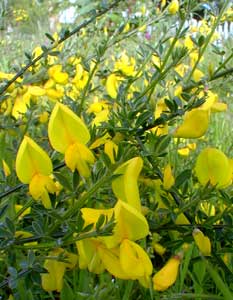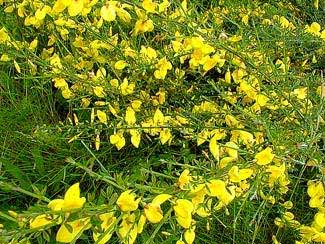
Invasive Scotch Broom
"Their groves o' sweet myrtle
let Foreign Lands reckon,
Where bright-beaming summers
exalt the perfume;
Far dearer to me yon lone
glen o' green breckan,
Wi' the burn stealing under
the lang, yellow broom.
Far dearer to me are yon
humble broom bowers
Where the blue-bell & gowan
lurk, lowly, unseen;
For there, lightly tripping,
among the wild flowers,
A-list'ning the linnet,
aft wanders my Jean.
-Robert Burns
(1759 - 1796)
Wild Scotch Broom (Cysitus scoparius) is an invasive, alien introduction into the Pacific Northwest. It is banned as a garden shrub here in Washington state. It's illegal to transport or sell the plants or seeds.(1759 - 1796)
But it's a tad late for any of that to have effect. A half-century ago when new highways then freeways were being carved up & down the coast, Scotch Broom was planted all along the roads because the plant was cheap & the extensive root systems kept the clear-cut mud-hills from washing back onto the freeways.
Though it was already used as a garden ornamental on the west coast in pioneer times, by the 1950s it was not quite the invader it his since become. It was definitely its use in holding up freeway embankments that turned it into such a problem.
To this day the freeways are lined with it. It has migrated into suburban neighborhoods & back roads, alongside parking lots, loving everywhere that bulldozers have been. It is the first thing to erupt in many clear-cuts.
 I can see it growing in a field immediately across the road from our house. It seeds onto our roadside green margin so that new shrubs appear every year at our property edge, despite that I periodically dig them out & discard them. It only takes three or four months of ignoring them & there will be six-foot-tall specimens to deal with again.
I can see it growing in a field immediately across the road from our house. It seeds onto our roadside green margin so that new shrubs appear every year at our property edge, despite that I periodically dig them out & discard them. It only takes three or four months of ignoring them & there will be six-foot-tall specimens to deal with again.The Oregon Department of Agriculture estimates that this noxious shrub costs that one state alone $47 million a year by out-competing native tree saplings in replanted clear-cuts, taking over pasture lands, & forcing costly actions to save native species when it invades national parks or sensitive areas. In California it has taken over a half-million acres of prime range land.
An unspoken cost to human health & environmental well-being is the amount of herbicides such alien species induce the government & private land owners to dump all over the place hoping to restrict the spread of invasives. A weevil that attacks broom seedpods, & a twig-mining moth that attacks broom limbs, have been unleashed in our Northwest coastal environment as biological controls. Who knows what other plants these exotic weevils & moths will end up harming.
Despite that they are on lists of weeds to be "managed" by the state, one doesn't see a great deal being done about it locally, except to criminalize getting caught with seeds. So it's a damned good thing it's a pretty shrub with such brilliantly yellow blossoms April through June, as what a bummer if they'd been not only invasive in Alaska, British Columbia, Washington, Oregon, & northern California, but ugly into the bargain.
It was not formerly found east of the Cascades, but has in recent years found its way inland via the wheels of motor vehicles, transport of sand & gravel, & possibly the droppings of migrating birds which pass the seeds undigested.
Scotch Broom is mildly toxic. While livestock loss is too rare to be a factor, the mild toxicity does mean that wild herbivores don't care for it, thus putting greater pressures on native plants which have smaller & smaller areas in which to thrive, but an increasing deer population to feed. About the only things that like to browse these tough semi-evergreen stems are goats.
But Scotch Broom can't be blamed entirely for what happens in the areas it takes over. Here in Washington, the sort of area it likes best of all are prairie & meadow & pasture ecosystems that do not already have native shrubs present. Broom rarely displaces our state's several wild vacciniums, for example, when such shrubs are already heathily established. In grasslands where it is not stopped by existing native shrubs, broom certainly would be capable of eliminating all smaller native species in its path, including grazable wild grasses. But it doesn't need to do this, because it has already been achieved by the human population factors of agriculture & housing development, which have already laid waste to the majority of broom's favorite type of ecosystem, damaged long before the brooms arrive.
This means, by & large, humans beat the scotch broom to the draw in wiping out native plants from the broom's preferred environment. It is mainly just "filling in" the spaces between human activity, being as it is well adapted to co-habiting with humans to a degree unmatched by our native shrubs. The harm broom might have done on its own is thus a moot point.
The picture isn't a thousand-percent awful. The good that it does is in fixing nitrogen into poor soils, & these nitrogens can be used by other plants once the broom is cleared out of the way. And of course there is its undeniable beauty. When it is in full pea-blossom, few can despise it.
Still, any that start blooming on our small property, I will at minimum cut them flush to the ground before they can go to seed. Cutting them back doesn't kill them, but at least they won't seed more specimens.
Happily for anyone who does love the beauty of this shrub, there are a great many restrained cultivars that are non-invasive. We have some of these, including one of the oldest varieties, Burkwood's Broom.
I remember as a child in the 1950s, yellow scotch broom was already all over the place. It would suck the ground dry with its extensive root system & nothing would grow on the ground beneath it. This meant us kids could crawl around underneath it, along a network of wonderful paths, without encountering stickers or undergrowth or even mud, the roots sucked the soil so dry. From us kids' point of view, those stands of broom were great.